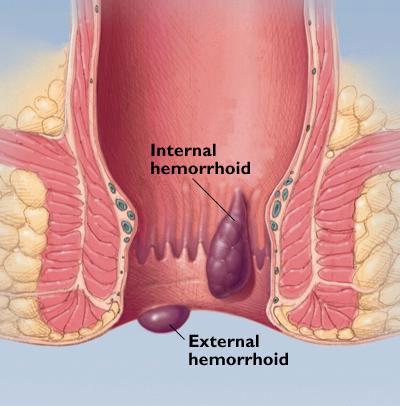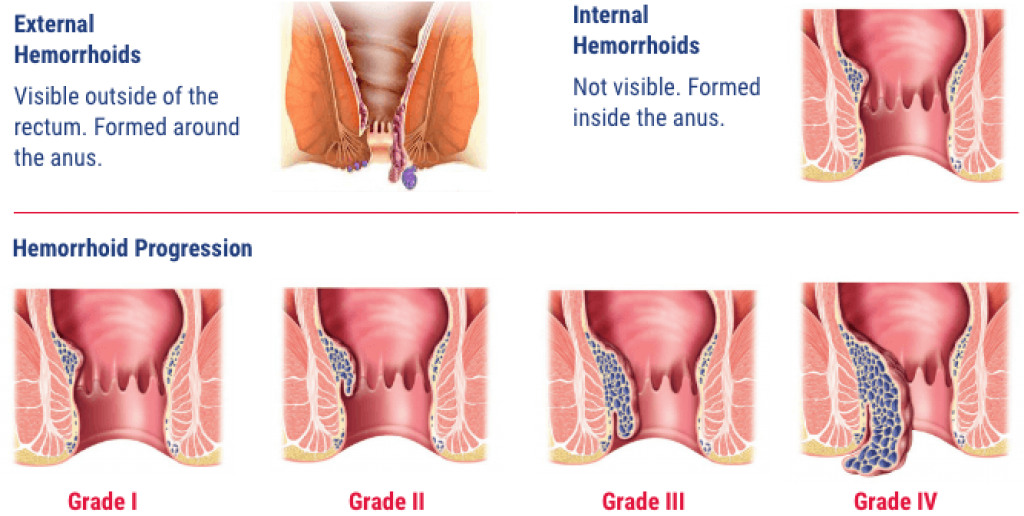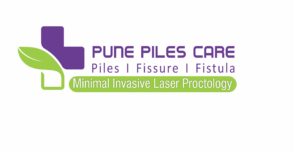Piles
What is Piles ?
Piles are collections of tissue and vein that become inflamed and swollen. The size of piles can vary, and they are found inside or outside the anus. Piles occur due to chronic constipation, chronic diarrhea, lifting heavy weights, pregnancy, or straining when passing a stool.
There are four types of hemorrhoids:
- internal
- external
- prolapsed
- thrombosed
Stages / Grade of Piles /hemorrhoids
- Grade one: Not prolapsed at all.
- Grade two: Prolapsed, but will retract by themselves. These may only prolapse when you put pressure on your anal or rectal area, such as by straining when you have a bowel movement, and then return to their normal position afterward.
- Grade three: Prolapsed, and you have to push it back in yourself. These may need to be treated so that they don’t become too painful or infected.
- Grade four: Prolapsed, and you can’t push it back in without a lot of pain. These will usually need to be treated to prevent pain, discomfort, or further complications.


Symptoms
In most cases, the symptoms of piles are not serious. They normally resolve on their own after a few days.
An individual with piles may experience the following symptoms:
- A hard, possibly painful lump may be felt around the anus. It may contain coagulated blood. Piles that contain blood are called thrombosed external hemorrhoids.
- After passing a stool, a person with piles may experience the feeling that the bowels are still full.
- Bright red blood is visible after a bowel movement.
- The area around the anus is itchy, red, and sore.
- Pain occurs during the passing of a stool.
Piles can escalate into a more severe condition. This can include:
- excessive anal bleeding, also possibly leading to anemia
- infection
- fecal incontinence, or an inability to control bowel movements
- anal fistula, in which a new channel is created between the surface of the skin near the anus and the inside of the anus
- a strangulated hemorrhoid, in which the blood supply to the hemorrhoid is cut off, causing complications including infection or a blood clot

शास्त्रीय दृष्टीने लेझरपेक्षा उत्तम
मुळव्याध लक्षणे (symptoms of piles)
१) रक्तस्त्राव (Blood in Stools)
२) वेदना (pain@ stools )
३) मलावरोध (Constipation)
४) सुज (Oedema @Anus)
5) पचनाचा तक्रारी (Indigestion)
मुळव्याध लक्षणे (symptoms of piles)
रक्तस्त्राव – Blood in Stools
१) संडास सोबत ५) संडास पुर्वी ३) संडास नंतर
१) रक्ताची चिळकांडी उडणे..
२) रक्ताची धार लागणे.
३) संडासला लागून रक्त जाणे
४) संडाससोबत थेंब थेंब पडणे.
मुळव्याध लक्षणे (symptoms of piles)
सुज (Oedema @ Anus)
१) संडास धुवते वेळेस
हाताला गाठ लागणे.
२) गाठेचा आकार कमी जास्त होणे.
३) गाठ अधुन मधुन हातास लागणे.
मुळव्याध लक्षणे (symptoms of piles)
१) छातीत जळजळ होणे
२) आंबट पाणी येणे
३) गॅसेस तयार होणे
४) अपचन
५) पचनाचा तक्रारी
मुळव्याध कारणे (Causes of piles)
आहारात्मक
१) तिखट, गरम मसालेदार पदार्थ अतिप्रमाणात खाणे
२) शुष्क (कठीण) पदार्थ खाणे
३) मटण, अंडी, कोबंडी, मासे आदि मांसाहार अतिप्रमाणात करणे
४) भुकलागल्यावर जेवण न करणे सोयीनुसार जेवणे, मी प्रमाणात जेवण करणे, पुर्वीचे जेवण पचले
नसतांना जेवणे अवेळी जेवन करणे
५) चवळी, हरभरा, वाटाणे, मटकी, वाल, पावटे, मसुर यासारखी वातुळ पदार्थ जास्त खाणे
मुळव्याध कारणे (Causes of piles)
आहारात्मक
६) कमी तंतुमय पदार्थ यांचे सेवण करणे (लौ फायबर डाईट) ७) जेवणात स्निग्ध पदार्थांचा अभाव असणे
८) चणे, मुरमुरे, बिस्कीटे, सँडविच ब्रेड, डोसा, पाव ब्रेड, पिझा इ. आंबविलेले पदार्थ, अति थंड पेय कोरडे पदार्थ यांचे नित्य सेवन करणे
९) रबडी, दही, मलई यासारखे पदार्थ अतिप्रमाणात खाणे
१०) दुषित खराब पाणी पिने, कमी प्रमाणात पिने, तिखट, तुरट, कडू चवीचे अन्न अतिप्रमाणत खाणे.
मुळव्याध कारणे (Causes of piles)
विहारात्मक
१) सायकल, स्कुटर घोडा या सारख्या कठीण आसनावर,
वाहनावर बऱ्याच वेळेस सतत प्रवास करणे
२) रात्रभर जागरण करणे
३) गुदभागास इजा होईल अशा जागी बसणे, बैठेकाम करणे
४) व्यायाम न करणे ५) अति प्रमाणात संभोग करणे
६) मलमुत्र विसर्जनाची संवेदना झाली तरी वेग रोखून धरणे
तसेच वेग नसताना जबरदस्तीने व घाईने उरकुन टाकणे
७) कठीण, उचसखल जागेवर तसेच वेड्यावाकड्या स्थितीत बसणे
८) गुदभागी सतत ताण पडने अशी कामे करणे.
मुळव्याध कारणे (Causes of piles)
१) पुरेशी झोप नसणे.
२) रात्री जास्त वेळ जागरण करणे.
३) कामाचा ताण-तणाव जास्त असणे.
४) व्यायामचा अभाव
५) अयोग्य आहार अयोग्य वेळी
६) जास्त वेळ बसुन काम करणे.
